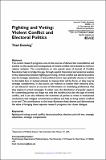| dc.description.abstract |
Two recent research programs-one on the sources of democratic consolidation and another on the causes and consequences of violent conflict—have tended to evolve in relative isolation. The contributions to this special issue of Journal of Conflict Resolution help to bridge this gap, through explicit theoretical and empirical analysis of the relationship between fighting and voting. Armed conflict and electoral politics may be strategic substitutes, in the political actors may optimally choose to submit to the ballot box or instead attempt to impose their will by force; or they may be strategic complements, in that actors use violence to bolster their electoral aims, or use electoral returns as sources of information on underlying preferences that they exploit in armed campaigns. In either case, the distribution of popular support for contending parties can shape not only the incidence but also the type of armed conflict, and it can also influence the incentives of parties to invest in institutional mechanisms that mitigate commitment problems and help to bring violent conflicts to an end. The contributions to this issue illuminate these themes and demonstrate the value of bringing these separate research programs into closer dialogue. |

